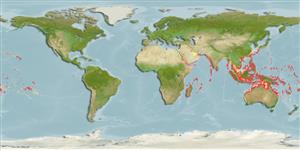Environment: milieu / climate zone / depth range / distribution range
ນິເວດວິທະຍາ
ສັດທະເລ ກ່ຽວກັນຫີນ; ລະດັບຄວາມເລິກ 0 - 50 m (Ref. 9710), usually ? - 20 m (Ref. 5222). Tropical; 35°N - 35°S, 28°E - 129°W (Ref. 5222)
Indo-Pacific: South Africa to French Polynesia. Not known from the Red Sea, Persian Gulf, nor Asian mainland.
Length at first maturity / ຂະໜາດ / ນ້ຳໜັກ / Age
Maturity: Lm 11.0, range 19 - ? cm
Max length : 36.5 cm TL ຕົວຜູ້/ບໍ່ມີເພດ; (Ref. 125599); ນ້ຳໜັກສູງສຸດທີ່ເຄຍຈັດພີມມາ: 1.0 kg (Ref. 125599)
ຄີ (ໜາມ)ແຂງຢູ່ຫຼັງປາ (ທັງໝົດ): 11; ຄີຫຼັງຂອງປາ (ຄີອ່ອນ) (ທັງໝົດ): 15-17; ຄີ(ໜາມ) ແຂງຢູ່ຄີກົ້ນປາ
ກຸ່ມປາກະດູກແຂງ
ຄວາມຖີ່ຂອງກຸ່ມຖ່າຍທອດພັນ
ປາທີ່ມີການເຄື່ອນຍ້າຍຈາກທະເລໄປຫານ້ຳຈືດ ແລະນ້ຳຈືດຫາທະເລ
ປາທີ່ມີການເຄື່ອນຍ້າຍຈາກທະເລແລະໄປໄຂ່ຢູ່ນ້ຳຈືດ
ຄີກົ້ນຂອງປາ
ສັດທີ່ມີກະດູກສັນຫັຼງ
ການຖ່າຍທອດທາງກຳມະພັນຈາກພໍ່ແມ່ຫາລູກ 3; ຄີກົ້ນຂອງປາ: 8. This species is distinguished by the following characters: greatest body depth 2.8-3.3 in SL; head length 2.3-2.6 in SL; preopercle rounded or subangular, the serrae at angle enlarged; upper edge of operculum almost straight; midlateral part of lower jaw with 2-4 rows of teeth, the inner teeth about twice length of outer ones; gill rakers of first gill arch 6-9 + 14-17; dorsal fin spines third to last subequal, the longest 2.4-3.2 in HL; anal fin spines second and third subequal, 2.1-3.0 in HL and longer than depth of peduncle; caudal fin rounded, peduncle depth 3.2-4.1 in HL; pectoral-fin rays 16-18; lateral-line scales 48-54, in series 98-114. Head, body, and fins pale, are covered with close-set (sometimes coalesced), dark brown or reddish brown spots, the interspaces forming an irregular pale reticulum; pectoral fins are covered with distinct small black spots, largely confined to the rays (the best diagnostic colour character of this species) (Ref. 39231, 89707, 90102).
A solitary fish, in coastal and offshore reefs usually in less than 20 m depth (Ref. 90102); also very common in shallow lagoon and semi-protected seaward reefs. Juveniles are common in thickets of staghorn Acropora corals. Feed on crustaceans and fishes. Increase of piscivory with age is observed in this species. Neither opercular spine nor anterolateral glandular grooves with venom gland is present (Ref. 57406). Current information in the table (dangerous fish) do not match; needs verification. Cultured under experimental conditions in the Philippines (Ref. 4757). In the Hong Kong live fish markets (Ref. 27253). It is important to artisanal fisheries because of its abundance in shallow water and caught with handlines, fish traps, and spear (Ref. 39231).
Life cycle and mating behavior
ການຈະເລີນເຕັມໄວ | ການສືບພັນ | ການວາງໄຂ່ | ໄຂ່ | ຄວາມດົກຂອງໄຂ່ປາ | ຕົວອ່ອນ
Heemstra, P.C. and J.E. Randall, 1993. FAO Species Catalogue. Vol. 16. Groupers of the world (family Serranidae, subfamily Epinephelinae). An annotated and illustrated catalogue of the grouper, rockcod, hind, coral grouper and lyretail species known to date. Rome: FAO. FAO Fish. Synop. 125(16):382 p. (Ref. 5222)
IUCN Red List Status (Ref. 130435)
Threat to humans
Reports of ciguatera poisoning (Ref. 30298)
Human uses
ການປະມົງ: ເປັນສີນຄ້າ; ການລ້ຽງສັດນ້ຳ: ເປັນສີນຄ້າ; ຊະນິດປາທີ່ຖືກນຳໃຊ້ເຂົ້າໃນການຫາເພື່ອເປັນເກມກິລາ: ແມ່ນ; ຕູ້ປາ: ບ່ອນວາງສະແດງສັນນ້ຳຂອງລັດ
ເຄື່ອງມື
Special reports
Download XML
ແຫຼ່ງອີນເຕີເນັດ
Estimates based on models
Preferred temperature (Ref.
123201): 24.6 - 29, mean 27.8 °C (based on 760 cells).
Phylogenetic diversity index (Ref.
82804): PD
50 = 0.5000 [Uniqueness, from 0.5 = low to 2.0 = high].
Bayesian length-weight: a=0.01202 (0.01064 - 0.01358), b=3.04 (3.02 - 3.06), in cm total length, based on LWR estimates for this species (Ref.
93245).
ຊັ້ນເຂດຮ້ອນ (Ref.
69278): 3.8 ±0.0 se; based on diet studies.
ຄວາມຢືດຢຸ່ນ (Ref.
120179): ສູງ, ປະຊາກອນຕຳ່ສຸດທີ່ໃຊ້ເວລາສອງໜ້ອຍກວ່າ 15 ເດືອນ (K=0.3-0.6).
Fishing Vulnerability (Ref.
59153): Low to moderate vulnerability (29 of 100).
Nutrients (Ref.
124155): Calcium = 48.4 [23.5, 101.6] mg/100g; Iron = 0.721 [0.369, 1.518] mg/100g; Protein = 18.4 [16.9, 19.8] %; Omega3 = 0.132 [0.080, 0.213] g/100g; Selenium = 32.9 [17.0, 64.7] μg/100g; VitaminA = 254 [64, 968] μg/100g; Zinc = 1.37 [0.91, 2.01] mg/100g (wet weight); based on
nutrient studies.
